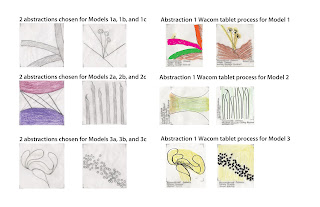From Abstraction 2, I chose three sets of two abstract drawings and used the Wacom digital tablet to process each abstraction and break each piece down to the simplest lines.
I redrew each abstraction paired with another and labeled them Abstraction 1A and 1B, 2A and 2B, and 3A and 3B.
Each set of two were combined with each other to make one abstraction which I used as a loose template for Models 1a, 1b and 1c, 2a, 2b and 2c, and 3a, 3b and 3c.
Abstraction 1:
The beginning of the drawn abstraction seemed to take on a radial-like shape, but is broken up by asymmetrical elements. I plan to incorporate the center radius into, at least, one spot on each model.
Abstraction 2:
I derived a seemingly unrecognizable, pictorial abstraction from two different interpretations of the stamen of an orange lily. The sketch is completely asymmetrical with fluid lines implying an ease of flow.
Abstraction 3:
Abstraction 3 begins with the geometric shape of 2A; a curvilinear and a rectilinear polygon of 2B placed together. Geometry is further reinforced by the parallel rectilinear structures, but broken up by a curved, asymmetrical shape at the tips.



No comments:
Post a Comment